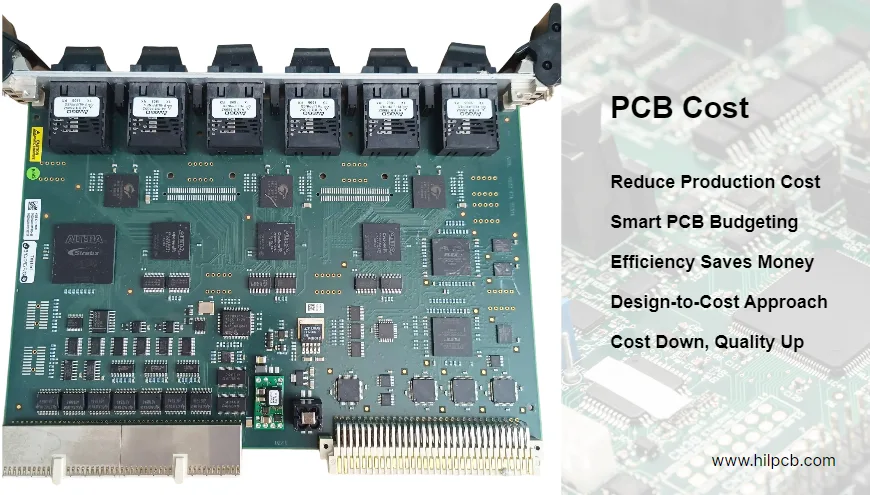Effective cost control is one of the most critical factors in competitive PCB manufacturing. Beyond the quoted unit price, multiple hidden and indirect expenses influence your overall production budget.
This article provides a structured breakdown of the PCB manufacturing cost model and explains how engineering design, material selection, and production planning can help you achieve sustainable cost optimization. For pricing structures and tiered models, see PCB pricing.
1. Understanding the Complete PCB Cost Structure
A professional PCB cost analysis begins with identifying how expenses are distributed across materials, processes, and operations.
Material Costs
Typically account for 35–45% of total expenses. This includes base laminates such as FR4 or Rogers materials, copper foil, solder mask, and surface finishes. The choice of substrate has the greatest influence—standard FR4 may cost $2–3 per square foot, while high-frequency laminates can reach $50–100.
Labor and Overhead
Represent about 25–35% of the cost. These include production line operation, engineering support, maintenance, energy, and quality control. Factories with higher automation reduce variable labor costs but require amortization of equipment investment across production volumes.
Tooling and Setup
Fixed costs such as drilling programs, testing fixtures, and stencil preparation usually range from $100–500 per project. For small runs, this cost significantly raises per-unit pricing; for high-volume production, it becomes negligible.
Testing and Quality Assurance
Account for 5–10% of total cost. Electrical testing, X-ray inspection, and impedance verification improve reliability but must be balanced against project requirements. Understanding the PCB lead time implications of testing processes helps manage schedules and costs effectively.

2. Major Factors Influencing PCB Manufacturing Costs
The total PCB manufacturing cost breakdown depends on design complexity, technical parameters, and selected materials.
Layer Count
Layer number is the primary driver of cost escalation. A four-layer PCB is typically two to three times the price of a two-layer board due to additional lamination cycles and process steps. Each layer beyond four can increase cost by 30–40%.
Design Specifications
Narrow trace widths, dense spacing, and microvias demand precision fabrication. For instance, traces below 4mil or vias smaller than 0.2mm require laser drilling and high-end imaging systems, often adding 20–30% to the cost.
Material Selection
Standard FR4 remains the most cost-effective option for general-purpose boards, while high-performance laminates such as Rogers 4350B or Taconic materials are necessary for RF and high-frequency designs. These can increase material cost tenfold.
Copper Thickness and Surface Finish
Copper weight above 1oz adds proportionally to material and etching costs. Similarly, premium finishes such as ENIG or immersion silver enhance solderability but raise expenses by 8–12% compared to HASL.
Efficient coordination with your supplier on PCB delivery terms ensures cost transparency throughout the production process.
3. Effective Strategies for Reducing PCB Manufacturing Costs
Cost optimization in PCB production requires both engineering precision and supply-chain planning. The following strategies consistently deliver measurable results.
1. Design for Manufacturability (DFM)
Integrate manufacturability considerations early in the layout process. Maintain standard design rules—trace width and spacing above 6mil, via diameters over 0.3mm, and consistent pad sizes. This prevents premium process charges and minimizes yield loss.
2. Optimize Layer and Size Utilization
Reducing layer count or board area can lower cost by 30–50%. Smart routing, stack-up planning, and efficient component placement achieve compact designs without compromising performance.
3. Improve Panel Utilization
Standard manufacturing panels measure 18×24 inches. Designing boards that align efficiently with these dimensions reduces waste and improves material yield, offering up to 20% cost improvement with no design compromise.
4. Order Quantity and Batch Planning
Setup and tooling costs distribute across quantity. While small prototype runs may exceed $40 per board, production volumes of 1,000 units can reduce per-board cost below $10. Aligning order frequency with demand forecasts helps maintain a balance between inventory and pricing advantage—see PCB procurement for sourcing best practices.
5. Lead Time Flexibility
Expedited PCB fabrication often costs 20–30% more due to schedule disruption and expedited material procurement. If project timelines allow, standard lead times are far more cost-efficient. To understand how manufacturing logistics affect timing and pricing, review PCB logistics and PCB shipping considerations.

4. Total Cost of Ownership in PCB Procurement
Focusing exclusively on per-unit pricing overlooks the true total cost of PCB ownership. In practice, the most economical supplier is the one who delivers consistent quality, reliability, and service stability. For supplier network analysis, see PCB sourcing.
Quality Reliability
Low-cost PCBs with high defect rates lead to rework, component loss, and production delays. The hidden cost of poor quality often exceeds initial savings.
Logistics and Supply Coordination
Small-batch shipments incur higher per-board logistics expenses. Consolidated orders and optimized freight planning reduce shipping and customs costs by up to 15%. A strong PCB supply chain infrastructure ensures predictability and minimizes risk.
Supplier Consistency
Schedule reliability and stable communication directly influence downstream operations. Trusted partners reduce unexpected downtime and enable smoother manufacturing flows.
Integrated PCB Assembly Services
Choosing a manufacturer offering end-to-end fabrication and assembly can minimize handling, coordination, and traceability issues. This approach may slightly increase per-board cost but lowers total project expenditure. Efficient management of PCB inventory further reduces holding and handling costs in long-term production.
5. Conclusion
An accurate PCB cost analysis demands a holistic approach—balancing engineering precision, production efficiency, and supplier reliability.
Manufacturers who optimize early design decisions, improve panel usage, and manage procurement strategically can reduce total costs by 25–40% without sacrificing product quality.
Long-term success in PCB cost reduction depends not on cutting corners but on understanding and controlling every parameter that influences your PCB manufacturing economics.

